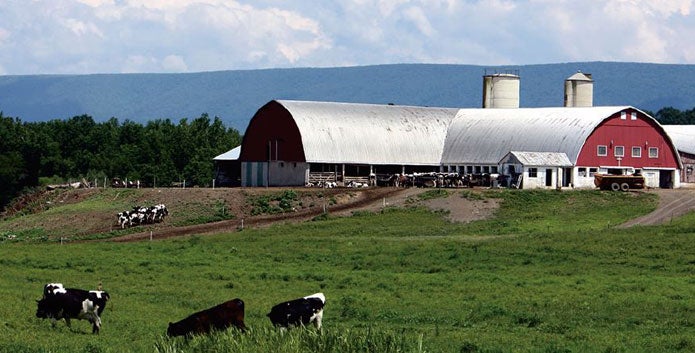There has been a surge in consumer interest for grass-fed beef products. The grass-fed beef sector has grown significantly over the last decade, and continued growth is expected. This is largely due to the perceived differences between nutrient values of grass-fed verses grain-fed cattle. People are becoming more aware of food production practices and understanding the origin of their food is a top priority for many consumers. There are a lot of people interested in purchasing pasture-raised, grass-fed beef over grain-fed beef because they believe grass-fed beef is healthier for them.
Generally speaking, all cattle are fed grass and hay or silage for the majority of their lives. The factor that varies is what farmers feed their cattle during the final 3-6 months before going to market. In the last few months before production, majority of farmers move their cattle to feedlots and feed their cows grains mixed with small amounts of forages. This is referred to as grain-fed or grain-finished beef. Barley and corn are most commonly fed to cattle, depending on the region in Canada. In comparison, farmers may also choose to keep their cattle in pastures and continue feeding on forages during the final months. This is known as grass-fed or grass-finished beef.
Some beef eaters have expressed concern over what grains are being fed to cattle before going to market. Corn, for example, is often given to cattle and has most likely been genetically modified. Health Canada has approved all genetically modified organisms (GMOs) available in Canada, and foods containing GMOs are considered safe to eat. No ill effects have been proven in the human population from consuming GMOs, although several advocacy groups claim the risks have not yet been identified or managed and would like more research done. The use of growth hormones in cows used for beef is also approved by Health Canada. Growth hormones are given to promote faster growth. Hormones also occur naturally in all animals, thus there is no hormone-free beef. Antibiotics are also used by farmers to treat sick animals and prevent disease. Both growth hormones and antibiotics are highly regulated by Health Canada and have not been proven as a threat to human health.
Regardless of what farmers are feeding their cattle, both grass-fed and grain-fed beef are supplying our bodies with a number of important nutrients. Beef naturally contains 14 essential nutrients that help our bodies build strong muscles and bones, support a healthy immune system, help wounds heal, and carry oxygen throughout our bodies. These nutrients include: protein, iron, zinc, phosphorus and B vitamins. There have also been a number of research studies done over the years investigating the nutrient content of both grass-fed and grain-fed cattle. Research is not conclusive in showing one type of beef is healthier than the other, but suggests:
- Grass-fed beef may have higher amounts of vitamin A and Vitamin E. These vitamins are also known antioxidants that help keep our bodies healthy.
- Grass-fed beef may contain more conjugated linoleic acid (CLA). CLA is a fatty acid that may slow tumor growth and development.
- Grass-fed beef may have higher amounts of omega-3 fatty acids, which play a protective role against heart disease.
- Grass-fed beef appears to be leaner and contain less total fat compared to grain-fed beef.
If deciding between grass-fed and grain-fed beef, it is important to understand both the breed of cattle and type of grass fed to the cows influenced the differences in nutrient content between studies.
In addition to the nutritional value, many people, including chefs, prefer the taste of grass-fed beef. They often describe grass-fed beef as more lean, beefy, and “mineral-like” due to being fed forages their entire lives. The flavour has also been described as richer, darker, and more robust. Some also find grass-fed beef has a distinct grassy flavour. Chefs have recommended trying grass-fed beef in ground meat form first as the steak can be a little tougher due to the lack of marbling when compared to grain-fed beef. If having grass-fed beef as a steak, some chefs suggest simply adding salt and pepper prior to grilling to enjoy the distinct flavours. If braising, it is recommended to use vegetables with high moisture or water content to help tenderize the less marbled grass-fed beef product.
Overall, grass-fed beef is more pricy compared to grain-fed beef. If you’re interested in purchasing grass-fed beef, try the following tips to help increase affordability:
- Provide smaller portions such as 3 or 4 ounce servings
- Use ground beef in entrees such as burgers, meatballs, and meatloaf instead of using premium-price steaks
- Provide other protein options in addition to beef, such as poultry and meatless proteins
References:
http://www.sciencedirect.com/science/article/pii/S0309174013004944
http://makeitbeef.ca/grass-fed-vs-grain-finished-beef-a-look-at-new-science/
http://www.ncbi.nlm.nih.gov/pmc/articles/PMC2846864/
https://www.eatrightontario.ca/en/Articles/Farming-Food-production/Hormones-and-antibiotics-in-food-production.aspx
http://www.inspection.gc.ca/food/labelling/food-labelling-for-industry/method-of-production-claims/eng/1389379565794/1389380926083?chap=9#s3c9










